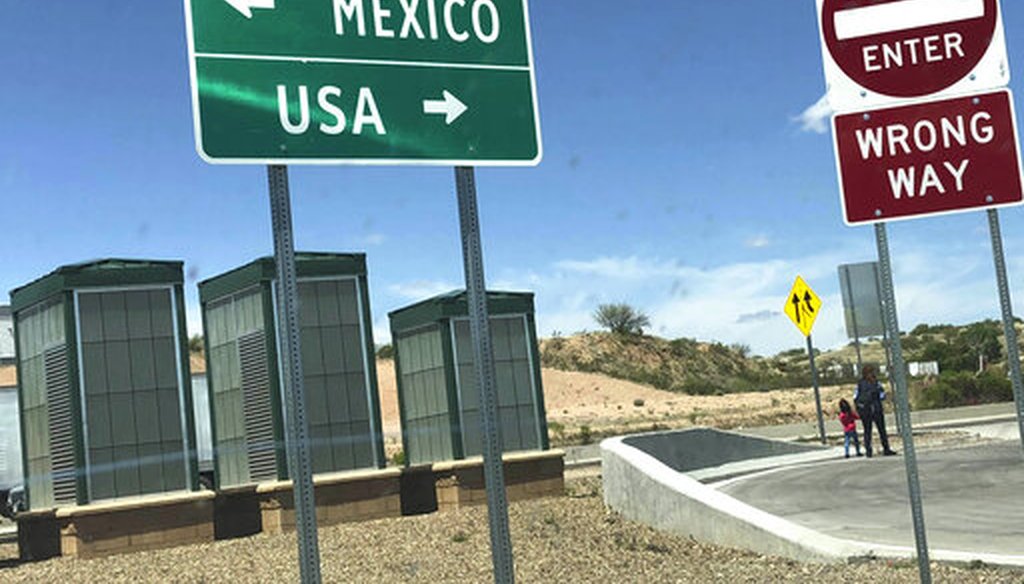

Our only agenda is to publish the truth so you can be an informed participant in democracy.
We need your help.


The Mexico-U.S. border check point near the Nogales/Mariposa Port of Entry in Nogales, Ariz. (AP)
In October, Rep. David McKinley, R-W.Va., visited the U.S.-Mexico border near McAllen, Texas, and argued that the United States needs stronger border security, including more border patrol agents.
A major part of the reason that additional resources are needed, McKinley said, is the flow of drugs into the country.
Border agents "say you’ve got to pay attention to this — $53 million a week is coming across the border in drugs," he said, according to the Intelligencer, the Wheeling News-Register.
Is this number correct? It’s more complicated than McKinley suggests, but he appears to be in the ballpark.
We’ll start by noting that the most solid federal data available concerns drugs seized on the border. While there are estimates for the amount coming through undetected, they are necessarily more speculative.
As a result, in this fact-check, we’ll interpret McKinley’s comment to refer to the amount being seized at the border. (McKinley’s office did not provide PolitiFact with further information.)
Here’s the most recent data on drug seizures — cocaine, heroin, marijuana, methamphetamine, and fentanyl — from Customs and Border Protection.
The official and most consistent way that Customs and Border Protection measures seizures is by pounds, not by value, an agency spokesman told us. So to approximate the value, we turned to other data sources on drug value.
For cocaine, heroin and methamphetamine, we used data published in October 2018 by the Drug Enforcement Administration and, for marijuana, we used data from the University of Colorado.
For fentanyl, information on value was unavailable from these sources. We decided to use a rough approximation of street value used by the Orange County, Calif., sheriff’s office in calculating the size of a bust in October 2019.
The following chart summarizes the approximate value of the fiscal year 2019 seizures. To create the chart, we converted pounds to grams.
Once you divide the total by 52 weeks in a year, the value is about $44.2 million per week.
That’s less than the $53 million figure McKinley cited, but it’s in the ballpark considering that the street value of drugs can fluctuate over time.
"There are no hard data, but I find the statistics cited to be consistent and certainly reasonable," said Bruce Bagley, a professor of international studies at the University of Miami who has studied the drug trade.
We should also note that the price per gram for cocaine, heroin, and methamphetamine is calculated on a pure gram of the substance. It’s unclear how pure the seizures were. In addition, the marijuana price data is for Colorado, a state where the drug is legal, and does not reflect the nation as a whole.
Another caveat: Even though McKinley visited the southern U.S. border, the seizure totals include those made on both the Mexican border and the Canadian border. That said, the DEA says that the southwestern border with Mexico "remains the primary entry point for heroin into the United States" and that "Mexico remains the most significant foreign source for marijuana available in the United States."
McKinley said that "$53 million a week is coming across the border in drugs."
If you interpret his statement to mean how much is reaching the border and is seized there, the available federal, state and local data puts the figure at about $44 million. That’s smaller than what McKinley said, but his number is a reasonable approximation given the uncertainty stemming from value fluctuations and other limitations of the data.
We rate the statement Mostly True.
The Intelligencer/Wheeling News-Register, "Rep. David McKinley Calls for Increase in Border Patrol Agent Ranks," Oct. 13, 2019
Customs and Border Protection, "U.S. Border Patrol Nationwide Drug Seizures," accessed Nov. 13, 2019
U.S. Drug Enforcement Administration, "National Drug Threat Assessment," 2018
Marijuana Policy Group and the Leeds School of Business at the University of Colorado-Boulder, "Market Size and Demand for Marijuana in Colorado," 2017 market update
Orange County Register, "Massive fentanyl bust highlights the opioid’s fast-growing threat in Orange County, authorities say," Oct. 18, 2019
Office of National Drug Control Policy, "What America’s Users Spend on Illegal Drugs: 2000-2010," February 2014
Email interview with Jonathan P. Caulkins, professor of operations research and public policy at Carnegie-Mellon University, Nov. 14, 2019
Email interview with Bruce Bagley, professor of international studies at the University of Miami who has studied the drug trade, Nov. 15, 2019
Email interview with Matthew Dyman, spokesman for Customs and Border Protection, Oct. 30, 2019
Email interview with Katherine M. Pfaff, spokeswoman for the U.S. Department of Justice, Oct. 30, 2019
In a world of wild talk and fake news, help us stand up for the facts.
